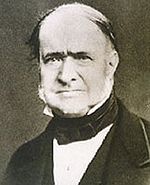
Marie Alfred Cornu was a French physicist. The French generally refer to him as Alfred Cornu.

Philippe Édouard Poulletier de Verneuil was a French paleontologist.

Christian Leopold von Buch, usually cited as Leopold von Buch, was a German geologist and paleontologist born in Stolpe an der Oder and is remembered as one of the most important contributors to geology in the first half of the nineteenth century. His scientific interest was devoted to a broad spectrum of geological topics: volcanism, petrology, fossils, stratigraphy and mountain formation. His most remembered accomplishment is the scientific definition of the Jurassic system.

The Corps des mines is the foremost technical Grand Corps of the French State. It is composed of the state industrial engineers. The Corps is attached to the French Ministry of Economy and Finance. Its purpose is to entice French students in mathematics and physics to serve the government and train them for executive careers in France.

Jean Baptiste André Dumas was a French chemist, best known for his works on organic analysis and synthesis, as well as the determination of atomic weights and molecular weights by measuring vapor densities. He also developed a method for the analysis of nitrogen in compounds.

Ours-Pierre-Armand Petit-Dufrénoy was a French geologist and mineralogist.

André-Jean-François-Marie Brochant de Villiers was a French mineralogist and geologist.

Gabriel Auguste Daubrée MIF FRS FRSE was a French geologist, best known for applying experimental methods to structural geology. He served as the director of the École des Mines as well as the president of the French Academy of Sciences.

William Daniel Conybeare FRS, dean of Llandaff, was an English geologist, palaeontologist and clergyman. He is probably best known for his ground-breaking work on fossils and excavation in the 1820s, including important papers for the Geological Society of London on ichthyosaur anatomy and the first published scientific description of a plesiosaur.

Edmond Hébert, French geologist, was born at Villefargau, Yonne.

Albert Auguste Cochon de Lapparent was a French geologist.

Jean Baptiste Julien d'Omalius d'Halloy was a Belgian statesman and geologist. He was the first to define the Cretaceous as a distinct geological period, in 1822. He produced the first geological map of France, the Benelux, the Rhineland and Switzerland, completed in 1813 and published in 1822. Halloysite, a clay mineral, was named in his honour. He also wrote on races.

Charles Joseph Sainte-Claire Deville was a geologist and meteorologist.

Joseph Jean Baptiste Xavier Fournet, French geologist and metallurgist, was born at Strasbourg.

Achille Ernest Oscar Joseph Delesse was a French geologist and mineralogist. He is credited for inventing the Delesse principle in stereology.

Alexandre-Émile Béguyer de Chancourtois was a French geologist and mineralogist who was the first to arrange the chemical elements in order of atomic weights, doing so in 1862. De Chancourtois only published his paper, but did not publish his actual graph with the irregular arrangement. Although his publication was significant, it was ignored by chemists as it was written in terms of geology. It was Dmitri Mendeleev's table published in 1869 that became most recognized. De Chancourtois was also a professor of mine surveying, and later geology at the École Nationale Supérieure des Mines de Paris. He also was the Inspector of Mines in Paris, and was widely responsible for implementing many mine safety regulations and laws during the time.

Joseph Henri Ferdinand Douvillé, also known as Henri Douvillé, was French paleontologist, geologist and malacologist. Douvillé worked as a mining engineer in Bourges (1872) and Limoges (1874), afterwards serving as professeur suppléant of paleontology at the École des Mines. From 1881 to 1911 he was a professor of paleontology at the École des Mines.

Boris Choubert or Schuberth was a Russian-French geologist. An adept of Wegener's theory, he was the first to precisely reconstruct the layout of the continental masses of Africa, America, Europe and Greenland prior to the fragmentation of Pangaea, thirty years before the article generally credited for this discovery.
Philippe-Louis Voltz was a French mining engineer, metallurgist, and geologist. He examined fossils in relation to stratigraphy and, with his knowledge of languages, took part in the interchange of ideas between French and German geologists.


















